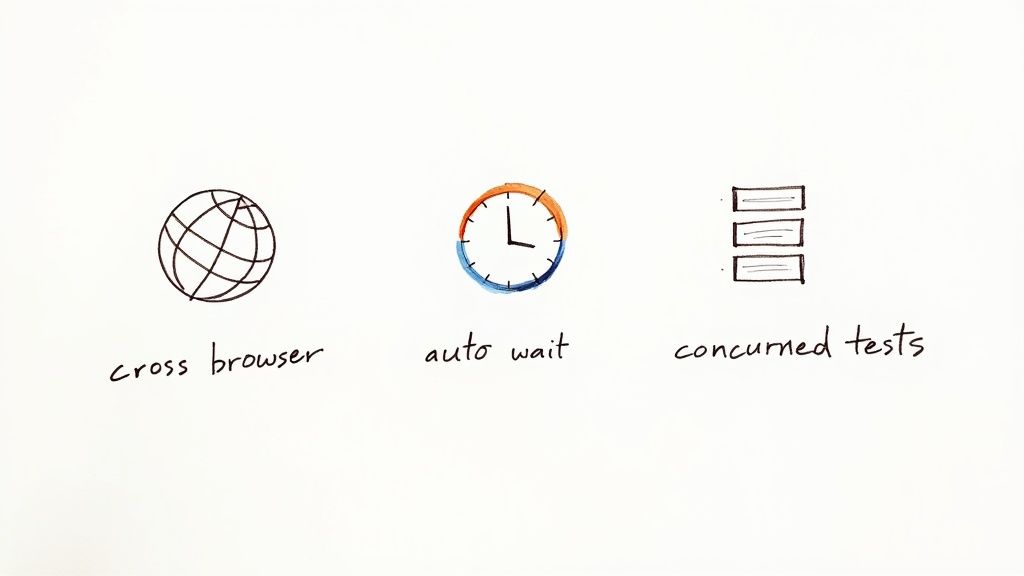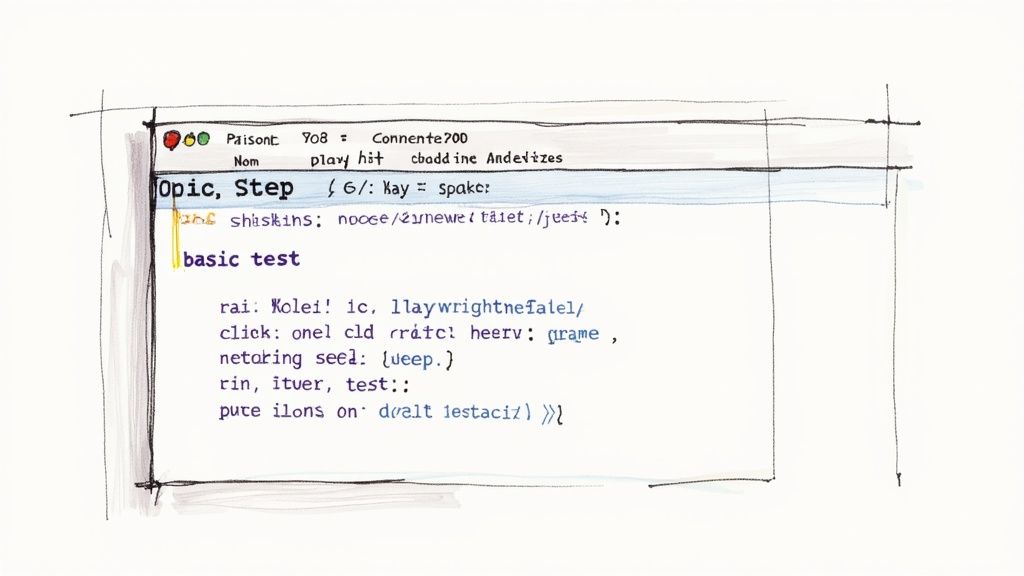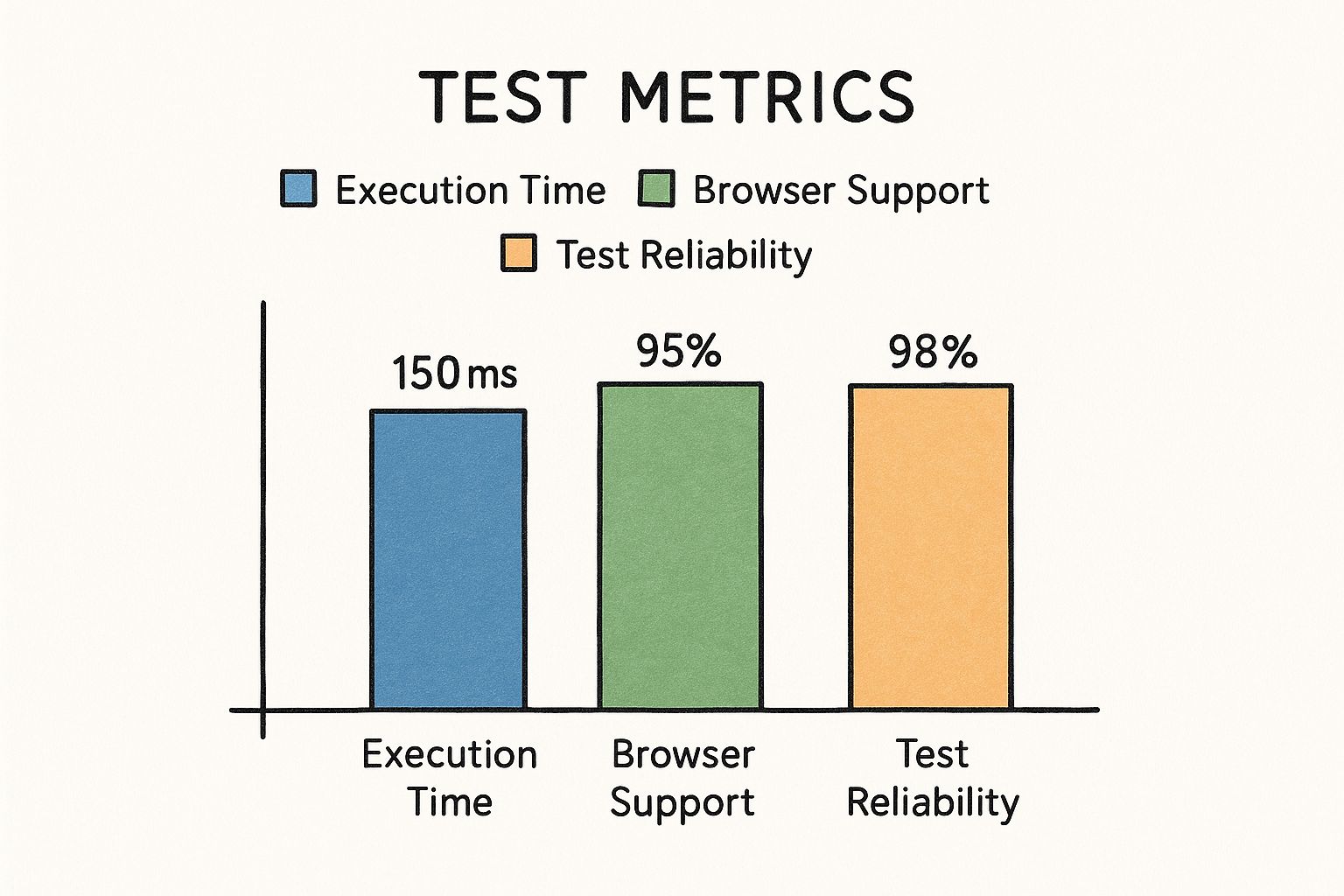What Is Playwright Testing and How Does It Work?

If you’ve spent any time in web development, you know the constant battle: making sure your beautiful, functional app works perfectly for everyone, no matter what browser they’re using. It's a huge headache. This is where modern testing frameworks come in, and one of the most exciting tools to emerge is Playwright.
So, what exactly is Playwright?
What Is Playwright Testing and Why Does It Matter?
Think of Playwright as a highly skilled digital assistant you can program to test your website. It's an open-source automation framework from Microsoft that lets you write scripts to interact with your web application just like a real user would—clicking buttons, filling out forms, and navigating pages with incredible speed and precision.

Its main job is to catch bugs, glitches, and inconsistencies long before your actual users ever see them. Instead of a developer manually clicking through the site again and again—a tedious and error-prone process—Playwright automates it all.
This automation frees up your team to focus on what they do best: building great new features. They can push code with confidence, knowing Playwright is standing guard, ensuring quality behind the scenes. It's a simple idea, but it’s the key to faster development cycles and much more reliable applications.
Cross-Browser Consistency is No Longer a Dream
One of the biggest historical challenges for web developers is making sure an application looks and works the same everywhere. A feature that's perfect in Chrome might be completely broken in Safari.
Playwright tackles this head-on by supporting all three major rendering engines:
- Chromium: The engine powering Google Chrome and Microsoft Edge.
- WebKit: The technology behind Apple's Safari.
- Firefox: The popular browser from Mozilla.
This means you can write a single test script and run it across all the big browsers. It’s a game-changer for guaranteeing a consistent, high-quality experience for every single user.
Playwright’s design philosophy is all about creating an automation tool that is reliable, fast, and capable. By managing browser instances directly, it sidesteps many of the common flaky issues that plagued older frameworks, leading to more dependable and faster test results.
A Rapidly Growing Favorite
Playwright isn't just another tool; it has quickly become a dominant force in the test automation world. You don't have to take our word for it—the community adoption metrics speak for themselves.
On GitHub, Playwright boasts over 74,000 stars, a clear sign of its popularity and developer trust. Even more impressively, an incredible 412,000 repositories now depend on Playwright for their testing needs. That kind of widespread adoption shows just how reliable and influential it's become.
To give you a clearer picture, here’s a quick rundown of what makes Playwright so powerful.
Playwright at a Glance
This table breaks down the core features that define Playwright and make it such a compelling choice for modern development teams.
| Feature | Description |
|---|---|
| Cross-Browser Support | Natively runs tests on Chromium (Chrome, Edge), WebKit (Safari), and Firefox. |
| Auto-Waits | Automatically waits for elements to be ready before performing actions, eliminating a major source of flaky tests. |
| Multi-Language Support | Write tests in TypeScript, JavaScript, Python, Java, or .NET. |
| Powerful Tooling | Includes Codegen to record user actions into scripts and Playwright Inspector for easy debugging. |
| Test Parallelization | Runs tests in parallel out of the box, drastically reducing the time it takes to get feedback. |
| Network Interception | Allows you to mock and modify network requests, making it easy to test edge cases and different server responses. |
| Cross-Platform | Runs on Windows, Linux, and macOS, both locally and on CI, in headed or headless modes. |
Ultimately, these features combine to solve a fundamental problem: ensuring software quality without slowing down development. By automating the repetitive work, Playwright empowers teams to ship better software, faster.
Digging Into Playwright's Core Features

To really get what makes Playwright a go-to tool for modern testing, we have to look past its impressive cross-browser support and dive into its smarter, developer-centric features. These tools aren't just add-ons; they're built-in solutions to the classic headaches of automation, making tests more reliable, quicker to write, and far less painful to debug.
This is the secret sauce that makes Playwright such a compelling answer for today’s quality assurance needs.
First up is Auto-Waits. We’ve all been there: you write a test to click a button, but that button only shows up after some background process finishes. In older frameworks, you’d have to jam a manual pause into your script and just hope it was long enough. Too short, and the test breaks. Too long, and you're just wasting precious time.
Playwright does away with all that guesswork. It intelligently waits for elements to actually be ready before it tries to interact with them, which dramatically cuts down on those "flaky" tests that fail for seemingly no reason.
Speeding Up How You Write and Run Tests
Another absolute game-changer is the Test Generator. This feature radically lowers the barrier to entry for creating automated tests. You just fire it up, click around in the browser like a normal user—hitting links, filling out forms—and Playwright writes the test script for you in the background.
This is huge for a couple of reasons:
- Newcomers: It’s an amazing, hands-on way to get a feel for Playwright’s syntax and how it all works.
- Seasoned Devs: It slashes the time spent writing boilerplate code, freeing them up to focus on the tricky parts.
By recording real user interactions, the Test Generator creates a script that's not just functional but also mirrors a realistic user path. It’s a massive productivity boost that makes getting started with new tests incredibly efficient.
Next, let's talk about Browser Contexts, which are key to Playwright's speed and rock-solid reliability. Think of a browser context as a completely isolated, "incognito-like" session. Each test runs in its own perfectly clean environment, complete with its own cookies, storage, and permissions. For a full rundown of its components, check out our complete guide to the Playwright testing tool.
This strict isolation means tests can't step on each other's toes. You could simulate two different users logging into your app at the exact same time without their sessions colliding. This structure is what makes it possible to run a massive number of tests in parallel, which drastically shrinks the time you spend waiting for your test suite to finish.
Instead of waiting minutes for feedback, you get it in seconds. Together, these features make Playwright a powerful framework that’s fast, dependable, and approachable for everyone on the team.
Why Modern Development Teams Choose Playwright

Understanding Playwright’s features is one thing, but seeing why so many development teams are jumping on board reveals its real impact. The decision isn't just about adopting a new tool; it's about getting better business results through faster, more dependable software delivery. Teams are picking Playwright because it hits the core challenges of modern web development right where it hurts.
Its biggest draw? Speed. In today's market, the ability to innovate and ship features quickly is everything. Playwright’s knack for parallel execution lets teams run hundreds of tests at once, shrinking the feedback loop from hours down to minutes. This means developers find out if their changes broke something almost immediately, paving the way for a much faster pace of development.
From Technical Gains to Business Wins
Reliability is the other side of the coin. For years, automated tests have been haunted by "flakiness"—tests that fail randomly because of timing quirks or slow-loading elements. It's a massive time sink and, worse, it erodes trust in your entire test suite.
Playwright’s architecture, with its smart Auto-Waits and rock-solid selectors, practically puts an end to this problem. When tests are dependable, developers actually trust the results. This confidence is the bedrock of a healthy CI/CD pipeline, letting teams merge and deploy code automatically without the fear of shipping new bugs.
The real magic of Playwright is how it turns technical wins into real business value. Shorter feedback loops and fewer flaky tests mean your team spends more time building new things and less time on frustrating bug hunts.
This mix of speed and reliability hasn't gone unnoticed. The fact that major companies are adopting it for mission-critical work speaks volumes. Over 5,900 companies worldwide now lean on Playwright for quality assurance. This includes giants like Boeing, American Airlines, and Toyota Motors, who trust it to ensure their complex digital products work as expected. You can explore more about Playwright's corporate adoption to see the full breakdown.
Tools That Empower Every Team Member
Beyond just speed and stability, Playwright’s tooling is genuinely practical for everyone on the team. Take the Trace Viewer, for example. It gives you a complete, step-by-step recording of a failed test run, complete with network requests, console logs, and even a video of the interaction.
This makes debugging unbelievably efficient. Instead of struggling to reproduce a bug, a developer can just pop open the trace file and see exactly what went sideways. This level of insight makes debugging accessible to everyone, from senior engineers to QA specialists, helping the whole team identify and fix issues faster.
At the end of the day, teams choose Playwright because it helps them build better products, faster. It clears out the common roadblocks in the development process, fostering a culture of quality and continuous improvement that you can feel on the bottom line.
How Playright Stacks Up Against Other Tools
When you're picking a testing framework, you'll find yourself looking at a few heavy hitters. To really get what makes Playwright special, it helps to see how it compares to long-standing tools like Selenium and the developer-favorite, Cypress. The goal here isn’t to declare one tool the absolute winner, but to look at the different philosophies and architectures that make each one the right choice for different situations.
For a long time, Selenium was the go-to for web automation. Its biggest advantage is a massive, mature ecosystem and years of community support. But that long history comes with a bit of architectural baggage. Selenium usually requires you to juggle separate WebDriver binaries for each browser, which can make getting started a bit of a headache.
Playwright takes a more modern, all-in-one approach. It comes bundled with the browser binaries it needs, which completely simplifies the setup process and guarantees that everything is compatible right out of the box. This self-contained design makes it much easier to get up and running.
Playwright Versus Cypress
Cypress has earned its popularity by focusing on an incredible developer experience. Its unique architecture runs tests directly inside the browser, which gives it lightning-fast and super-reliable access to your application's DOM. This makes it a fantastic choice for front-end developers who need immediate feedback as they're building UIs.
The main trade-off with Cypress, however, has always been its cross-browser support. While it has improved, it doesn't quite match the native, multi-engine coverage that Playwright offers. Playwright’s ability to run the exact same test script across Chromium, WebKit (the engine behind Safari), and Firefox from a single API gives you a much stronger guarantee that your app will work consistently for everyone.
Playwright’s secret sauce is its ability to talk to browsers at a much lower level, closer to how the browsers themselves are built. This direct line of communication, combined with its bundled browsers, leads to faster execution and rock-solid reliability across every major platform.
The image below gives you a sense of the performance and reliability metrics that make modern frameworks like Playwright so compelling.

As you can see, the high marks in browser support and test reliability are what get teams excited about Playwright. To make the choice clearer, here’s a direct, side-by-side comparison of the big three.
Playwright vs Selenium vs Cypress Feature Comparison
The world of web automation is dominated by a few key players. This table breaks down the core differences between Playwright, Selenium, and Cypress to help you see where each one shines.
| Feature | Playwright | Selenium | Cypress |
|---|---|---|---|
| Cross-Browser | Excellent (Chromium, WebKit, Firefox) | Excellent (Requires separate drivers) | Limited (Mainly Chromium-based, some Firefox/WebKit) |
| Test Speed | Very Fast | Moderate | Fast |
| Architecture | Modern, controls browser via protocol | Classic WebDriver API | Runs inside the browser |
| Setup | Simple, all-in-one | Complex, requires drivers | Simple, all-in-one |
| Auto-Waits | Built-in and robust | Requires explicit waits | Built-in and robust |
Ultimately, there's no single "best" tool for every job. The right choice really comes down to what your project needs, where your team's expertise lies, and what you value most in a testing workflow.
How to Run Your First Playwright Test
Jumping into a new tool can feel intimidating, but Playwright makes getting started surprisingly simple. You can go from zero to a running test in just a few minutes, all thanks to an intuitive command-line tool that does the heavy lifting for you.
Let's walk through it.
Getting your environment ready is as easy as running a single command in your project’s terminal. This kicks off an interactive setup that not only installs Playwright but also downloads the browsers you'll need and creates a basic project structure.
npm init playwright@latest
Once you run this, Playwright asks a couple of questions—like whether you prefer TypeScript or JavaScript and where to put your tests. It then generates a configuration file (playwright.config.ts), a tests folder, and even an example test file so you can get going immediately.
Understanding a Basic Test Script
Now, let's look at the example test Playwright just created. It’s designed to be clean and to show you the core pieces of any test you'll write. The basic anatomy of a Playwright test boils down to three key concepts: test, page, and expect.
test: This is the function that wraps a single test case. You give it a descriptive name and a function that contains the test logic.page: Think of this object as your personal, automated browser tab. It’s your main tool for interacting with the web page—navigating, clicking, and typing.expect: This is how you make sure things worked. It's the function you use for assertions, checking if the application behaved as you intended, like verifying that a specific piece of text is now visible.
Here’s a simple, real-world example. Imagine you want to test the search functionality on a blog. Your test would navigate to the blog, type a search term, and then check if the results page shows up correctly.
import { test, expect } from '@playwright/test';
test('should find search results for "automation"', async ({ page }) => { // 1. Go to the website await page.goto('https://example.com/blog');
// 2. Find the search bar and type in it await page.getByPlaceholder('Search articles').fill('automation');
// 3. Click the search button await page.getByRole('button', { name: 'Search' }).click();
// 4. Check that a result title is now visible await expect(page.getByText('Results for "automation"')).toBeVisible(); });
This short script shows just how readable Playwright tests can be. Each line clearly states its purpose, making the test easy for anyone on the team to understand, even if they're new to the framework.
By combining navigation (goto), actions (fill,click), and assertions (expect), you create a powerful, automated check that validates a key user journey. This simple pattern is the foundation for building more complex test suites.
As you build out more complex scenarios, you can master Playwright automated testing by exploring more advanced locators and assertions. The framework is designed to grow with your needs, scaling smoothly from simple checks to intricate end-to-end verifications.
Integrating Playwright into a CI/CD Pipeline
Running Playwright tests on your local machine is a great start, but the real magic happens when you plug it into a professional development workflow. This is where Continuous Integration and Continuous Deployment (CI/CD) comes in. Think of a CI/CD pipeline as an automated assembly line for your code.
Every time a developer pushes a change, this assembly line automatically builds, tests, and gets the code ready for release. In this setup, Playwright testing becomes your most important quality control checkpoint. It’s the safety net that ensures buggy code never makes it to your users. You can dig deeper into the fundamentals of this process in our guide on what a CI/CD pipeline is.
Automating Quality Control
Setting this up is more straightforward than you might think. Tools like GitHub Actions or GitLab CI let you define a workflow that kicks off your Playwright test suite automatically on every single commit or pull request.
Here’s a typical play-by-play:
- A developer commits new code.
- The CI/CD pipeline triggers automatically.
- The pipeline builds the application.
- It then runs your entire Playwright test suite in a clean, consistent environment.
- If all tests pass, the code gets the green light for the next stage, like being merged or deployed. If even one test fails, the pipeline stops and alerts the team.
This automated feedback loop changes everything. It shifts quality control from a manual, end-of-stage chore to a continuous, integrated part of how you build software.
By running Playwright tests automatically, you create a system where code quality is constantly verified. This allows teams to move faster and deploy new features with a high degree of confidence, knowing that a rigorous set of checks has been performed.
This tight integration is a cornerstone of modern software delivery. Recent industry trends show that seamless CI/CD integration, along with AI-assisted workflows and advanced cross-browser testing, are solidifying Playwright’s strategic position in the market. As demands for complex web apps grow, this kind of precise, automated UI testing becomes essential for meeting quality standards. You can discover more about Playwright's evolving capabilities and its role in modern development. This ensures that every deployment is a confident step forward, not a risky gamble.
Digging into Playwright: Your Questions Answered
As you start exploring Playwright, a few questions always seem to come up. It's only natural. Let's tackle some of the most common ones with straightforward, practical answers to help you see what it’s really capable of.
Can Playwright Test More Than Just Websites?
You bet it can. While Playwright is a star at UI automation, it also packs a powerful, built-in API testing module. This is a game-changer.
It means you can write tests that hit your backend services directly—sending requests, checking responses, and validating data—all without ever spinning up a browser. This dual capability makes Playwright an incredibly efficient tool for true end-to-end testing, letting you cover both what the user sees and the APIs humming away in the background.
Is Playwright Too Hard for Beginners?
Not at all. In fact, it’s one of the most approachable automation tools out there, especially if you're just getting started.
The secret weapon for newcomers is the Test Generator (you'll also hear it called Codegen). You just click around in a browser, and Playwright writes the test code for you. It's a brilliant way to learn by doing.
When you combine that with its clean syntax and excellent documentation, you'll find yourself writing solid tests much faster than you'd expect.
Does It Handle Modern Web Apps Well?
Yes, and honestly, this is where Playwright truly shines. Modern web apps built with frameworks like React, Angular, or Vue are notoriously tricky because content loads and changes on the fly.
Playwright's Auto-Waiting mechanism was built for exactly this world. It intelligently waits for elements to be stable and ready before it tries to click or type, which stamps out a huge source of flaky, unreliable tests. It just gets how today's complex web environments work.
Ready to stop wrestling with flaky tests and slow CI pipelines? Mergify integrates powerful automation like Merge Queues directly into your workflow, ensuring your Playwright tests run efficiently and your code stays stable. See how Mergify can streamline your development process.





